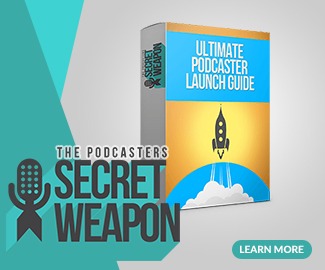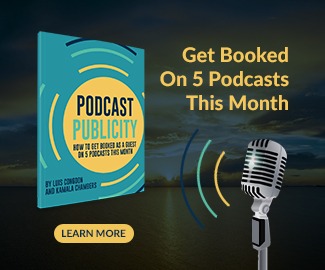Elements Of A Story – Paul Smith
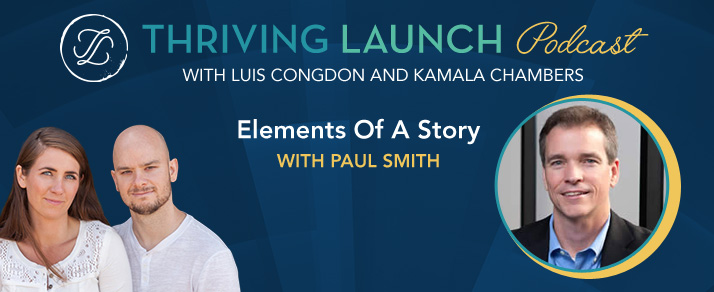
SUMMARY
In this episode, Paul Smith, a leading expert in storytelling, talks about the elements of a story that we can use to make a powerful impact and influence others.
It is your story that makes you memorable.
KEY TAKEAWAYS
![]() Leadership, sales, and marketing are all about influencing people.
Leadership, sales, and marketing are all about influencing people.
![]() Stories are the best vehicle to communicate to the subconscious, emotional part of the brain.
Stories are the best vehicle to communicate to the subconscious, emotional part of the brain.
![]() Stories make things easier to remember.
Stories make things easier to remember.
![]() At the core of any great story are a hero we care about, a villain we’re afraid of, and an epic battle between them.
At the core of any great story are a hero we care about, a villain we’re afraid of, and an epic battle between them.
![]() Your story is what makes you memorable.
Your story is what makes you memorable.
![]() In the first few seconds, give the buyer a reason to listen to the rest of your story.
In the first few seconds, give the buyer a reason to listen to the rest of your story.
![]() You can’t just give a sales pitch and call it a story.
You can’t just give a sales pitch and call it a story.
![]() There’s a big difference in a genuine story and a sales pitch.
There’s a big difference in a genuine story and a sales pitch.
![]() Great salespeople tell stories throughout the entire sales process.
Great salespeople tell stories throughout the entire sales process.
![]() If there’s not a background story behind a product, don’t invent one.
If there’s not a background story behind a product, don’t invent one.
![]() For business people, the four essential elements of the story are:
For business people, the four essential elements of the story are:
- A relatable main character.
- A relevant challenge.
- An honest struggle.
- A worthy lesson.
TRANSCRIPTION: ELEMENTS OF A STORY – PAUL SMITH

Kamala Chambers
On this episode, we’re going to be talking about the elements of a story, the power of storytelling and how to use your story to create influence.
Today, we are here with one of the world’s leading experts in storytelling, Paul Smith. He’s a keynote speaker, a storytelling coach, and the author of many books and bestsellers.
We’re excited to have him here talking with us about the elements of a story.

Luis Congdon
Hey, Thriving Launchers, I can’t wait to talk to you today about the elements of a story and how to lead with it.
Without further ado, let’s welcome Paul Smith.
Are you ready to launch Paul?

Paul Smith
Yes, I am. Thank very much for having me on the show.

Luis Congdon
One of the reasons why Kamala and I felt you are a great fit for the show and the Thriving Launch community is you’re someone honed in on this aspect and the elements of a story and the way you lead into sales, into connection, into anything you want to do in business.
A story has to be at the centerfold, and I’m curious why you latched onto that. You even titled your book Lead with a Story, and you have a website. This is a crucial thing for you, and I’m curious. Why is that important?

Paul Smith
I have to admit I’m probably a slow learner.
It’s not as I came out of college thinking, “Hey. I want to do with my life is write books about storytelling and do that for a living.” I spent 20 years working in a pretty typical corporate career path. First thing, consulting and then, 20 years at Procter and Gamble.
Learning The Elements Of A Story

Paul Smith
I think I just eventually noticed that the leaders I most admired and most wanted to be like when I grew up in the company had this uncanny ability to tell compelling and engaging stories.
I looked back, and I realized that nobody thought me the elements of a story in business school when I was getting an MBA, and no one taught me that when joined these companies I worked for.
And so, I set out to learn the elements of a story on my own. I ended up interviewing 250 or 300 CEOs, executives, and sales people, and dozens of companies all over the world. I was looking for “What kind of stories do they tell?” and “How do they tell them and are they effective?”
I just eventually reverse engineered my way into the elements of a story that makes it compelling. I probably documented 2000 or 3000 at this point, and somewhere along that route, it stopped just being Paul’s personal learning journey and became, “I guess if I want to know the elements of a story that badly, probably other people do as well?” So it became an idea for a book, which launched me into a new career.
Long way of answering your question is I realized how important learning the elements of a story was to the people I wanted to be like. But I couldn’t find a way to learn it very well so I just had to do it on my own.

Kamala Chambers
Why is it important to tell our stories? What is it that we can gain from doing that?
Because I know a lot of people are afraid of getting their story out there, being able to open up publicly, and be that vulnerable.

Paul Smith
Yes. There are number of reasons. I’ll give you just 2 or 3 of the most important ones I think.
Importance of Storytelling And The Elements Of A Story
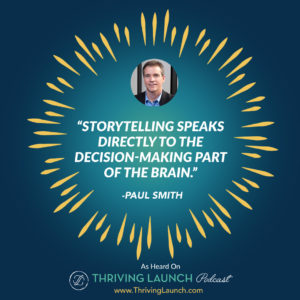

Paul Smith
A lot of the cognitive science that’s been done in the last few decades confirms this. It turns out that human beings make unconscious, emotional, sometimes even irrational decisions in one place in their brain. Then they rationalize those decisions a few nanoseconds later in some other place in the brain which is the conscious processing center.
We finish making every decision we make thinking that we’ve made up for this very rational, logical decisions. The truth is we made it for some unconscious emotional decision and we just rationalized it.
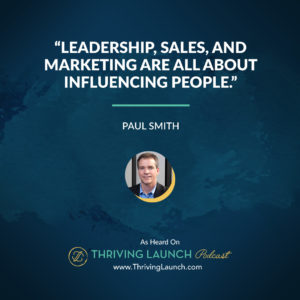

Paul Smith
If you want to influence what people think, what they do, and their opinions, you need to speak to that part of their brain where they’re making their decisions.
Elements Of A Story As The Best Vehicle

Paul Smith
It turns out that stories are the best vehicle to communicate to that subconscious emotional part of the brain.
Whereas, facts, figures, logic, and rational thought doesn’t speak to that part of the brain because that part of the brain just doesn’t process that. That’s probably the big reason.
Elements Of A Story Are Easy To Remember

Paul Smith
A couple other reasons are it makes things easier to remember.
Numbers of studies have shown that facts are far more likely to be remembered if they’re embedded in the elements of a story than if they’re just given to people in a list.
And so, when you’re trying to teach somebody and get them to remember something, if it’s one of the elements of a story, you’ll have much more odds of success.
Wow Reactions To Elements Of A Story

Paul Smith
Stories, whether it’s during a presentation, a speech, or even a hallway conversation with somebody else tend to be the kind of things that people react with a “Wow” to.
When was the last time you heard somebody say, “Wow! You’ll never believe the PowerPoint presentation I just saw.” Nobody says that but they will say that about a great story. I think that’s the reaction you want to the kind of words coming out of your mouth.

Kamala Chambers
I definitely find that when I used to sell Amazon herbs. I found that every time I did a presentation, people always latch on to the elements of a story that I told about the founder of the company way more than all of the facts about the benefits or how it was affecting the tribes in the Amazon, and all of that.
I would love to hear from you some elements of a story that makes it good. What are some of the essential elements to make a good story?
Elements Of A Story That Makes It Good

Paul Smith
I think no matter what type of storytelling you’re talking about whether it’s business storytelling, a movie, or a novel.
There are three things at the core of any great story. Those are; a hero we care about, a villain we’re afraid of, and an epic battle between them.
I think Star Wars, you got your Darth Vader and your Luke Skywalker, and the epic battle between them. I’ll admit that sounds rather Hollywood.
If we were to translate that into business language, what that would equal would be a relatable hero or a relatable main character and a relevant challenge. The villain becomes a relevant challenge because it doesn’t have to be a human or a person. It could be a competitor you’re competing against or the problem you’re trying to solve. The epic battle becomes just an honest struggle.
The audience needs to see in your story an honest struggle between the main character and the challenge they’re facing.
If what they’re trying to accomplish is too easy, it’s not going to be an interesting story.
Elements Of A Story For Business People

Paul Smith
For business people I would say, the three elements of a story are:
- A relatable main character.
- A relevant challenge.
- An honest struggle.
You have to add one more thing to the elements of a story since it’s not just for entertainment value. That is a worthy lesson at the end and is something that can drive them to action. It can be “Buy my product” or “Please. Join my company as our first employee” or whatever happens to be. You need a worthy outcome, a worthy lesson from that story.
If you got those four elements of a story, even if you butcher a whole lot of the other details we could talk about, you’re going to have a pretty good story.

Luis Congdon
It reminds me of one of our interviews with Kevin Rogers that we did Kamala. Kevin Rogers is a very well-known copywriter, and one of the things he was talking about was he referenced his website.
Using Elements Of A Story To Business

Luis Congdon
Essentially, what they do is they go and buy products from EBay or garage sales, and items that are basically not all that valuable like a toothbrush or maybe an earring.
What they’ll do is they’ll craft the elements of a story in it. Then they’ll put it up on a website like Ebay, and their own website, and see how much they can sell it for, and they’re always able to sell their items for more than what they bought it for because they put the elements of a story there.
That’s something for you guys listening because what Paul is driving at is your story will help you sell and your story is what makes you memorable. That’s what Kamala was saying too.
Hero’s Journey As Elements Of A Good Story

Luis Congdon
The course that I taught and is a course all about how to use Facebook, and how to use Facebook organically to draw or attract your ideal client and audience, one of the things I talked about there is the hero’s journey.
Joseph Campbell has that and all the great stories we look at. You said something about, maybe this sounds a little too Hollywood but it doesn’t. It’s pure academic study as well of what makes great literature.

Paul Smith
Yes. Here’s a couple of reaction to that.
That EBay study you’re talking about was a great one. If folks want to look it up, that was done in 2009 by Rob Walker and Joshua Glenn. It’s called the Significant Objects project. It’s just like you described it, but they can look it up and see the statistics. It’s quite amazing.
As far as Joseph Cambell‘s Hero’s Journey, I’ll definitely agree with you. There’s a lot of science and studies that’s gone into what makes for the structure of a well told story. Certainly, he did a lot of that with mythology.
But what I have found is that particular structure, the 17-Step Joseph Campbell Hero’s Journey Story Structure is a bit too long and convoluted for business people to use effectively. The kind of stories he studied in putting that structures together were epic novels. It was Gilgamesh. It was these big, long, 400-page tombs of stories.

Luis Congdon
We don’t have that kind of time on stage or that kind of time when somebody is scrolling through our website.

Paul Smith
Right, exactly. I’ll tell you exactly how long you’ve got.
Length And Elements Of A Story

Paul Smith
When you’re telling a leadership story and this is an oral story. You’re standing up in front of an audience or you’re in a hallway with somebody. You’re in your office and you’re telling a verbal story, and it’s more of a leadership story. This is somebody who works for you or works with you or you work at the same company.
The average length of those types of stories in the office is four minutes. Not two hours in a movie theater. It’s not 300 pages in a book. It’s four minutes and 600 words long.
Sale stories from a professional salesperson to a professional buyer, a professional marketer to a professional buyer, takes two minutes, 300 words. That’s average.
If you’re thinking about marketing like television ads, of course, those are even shorter, 30 seconds or 15 seconds or whatever.
But the professional sales stories people tell, they range from about 30 seconds to 3 minutes, and they average two minutes.
What I’ve found is that Joseph Campbell’s Hero’s Journey is just too long and convoluted.
Four Elements Of A Story

Paul Smith
So what I typically advocate is just four elements of a story.
We can talk more about what those elements of a story are but you need something specific enough to give you guidance on what needs to go in my story, and what’s not in my story.
But if you have to come up with all of the twists and turns of a Joseph Campbell thing, you’re not going to get that done in two minutes.

Kamala Chambers
I want to hear more about those four elements of a story.
Can we go deeper into the first step?

Paul Smith
Yeah.

Luis Congdon
Kamala loves practicality and I love how we can take 17 Steps from Joseph Campbell, one of the greatest authors, and storytellers of sharing with us the Hero’s Journey.
But now, in today’s age, the elements of a story we have are very different than a 400-page book.
Go ahead and continue with the elements of a story.

Paul Smith
So, those are the four main elements of a story.
The elements of a story are context, challenge, conflict, and resolution, and what I typically coach people as they’ve asked me as I’ve gone and coached people on this. They said, “Yeah, but I need a way to get into my story. How do I kick off and start my story?”
Let me add a little part for that and then, after the story’s done, remember, I said you need a worthy lesson or some action driven at the end like, “You need to buy my product” or “You need to join my company” or whatever.
There are a couple of steps after you’re done with the storytelling and then, one step before you start. I could group them into seven or eight but the easier way I think to discuss it is just, what questions do your story need to answer for the audience? And what order does it need to answer them?
There are just eight questions, and you can cram all those into two sections if you want. It doesn’t matter but it’s just eight questions.
Questions You’ve Got To Answer And Elements Of A Story

Paul Smith
Here are the eight questions in the order in which you’ve got to answer.
- Why should I listen to the story?
If you don’t answer that for your audience right up front, they will either mentally, physically, or emotionally walk away from you. They won’t even listen to your stories.
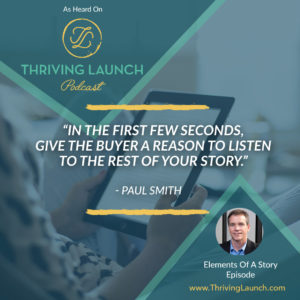

Paul Smith
- When and where did it take place?
- Who’s the main character and what did they want? That’s the context.
- What was the problem or opportunity they ran into? That’s the challenge.
- What did they do about it? That’s the conflict or the struggle in the story.
- How did it turn out in the end? That’s the resolution of the story.
Elements Of A Storytelling When It’s Done

Paul Smith
If you’re counting, that’s six. And so, there are two more questions that are after the storytelling is done.
- What did you learn from it?
- What do you think I should do now? That’s where you get an opportunity to make a recommendation.
But if your story answers those eight questions in that order, you’ve pretty much got the elements of a story. At least, in terms of the structure of the story and all of the other extraneous stuff that doesn’t answer those eight questions is probably more than you have time for in two minutes.

Kamala Chambers
Sometimes, when I talk with clients about trying to form their story because it’s such an important piece in writing their sales page, putting out post on social media, and all of it, they have to know what their story is.
Are there any tips that you have to kind of dive in deeper to unlock what elements of a story we should include?

Paul Smith
Yes.
It’s probably helpful to step back.
Let’s talk about what a story actually is because a lot of times, people use that word and they mean something very different.
Imagine it’s next Monday morning 9 o’clock. You’re at a meeting with other people at work, and you got a sales call on a new prospect that’s going to happen in the couple of weeks, and everybody’s preparing the presentations for that sales call.
And then, the meeting is starting. The boss walks in, puts her hands on the table, leans out over and says, “All right people. What’s our story?”
Do you think for a minute that what she means by story is an actual narrative about something that happened to somebody one time?

Luis Congdon
Definitely not.

Paul Smith
Right.
Elements OF A Story And What It Means

Paul Smith
What she means is the series of logical facts, arguments, and data that we’re going to put together, probably in a powerpoint presentation. And essentially walk our prospect through such that by the end of the meeting, we got the highest odds of making a sale. That’s what she means by story.
20 years ago, nobody would have called that a story. They would have called it a sales pitch or a message track or talking points or just presentation slides.
But today, people call that, “That’s my story.” In my vernacular, that’s not a story at all. That’s a sales pitch, and that’s fine. You need sales pitches. You need message tracks, you need presentation slides. I’m not poo pooing any of that stuff.
Actual Elements OF A Story

Paul Smith
But if you want to talk about actual elements of a story to get you the benefit of tapping into that emotional side of the brain where people make decisions that engages people in a way that’s more personal, and they will remember forever, you got to do a real story telling.
You can’t just give a sales pitch and call it a story, and think that’s going to work. The brain doesn’t work that way. You have to do actual storytelling.
Difference of Sales Pitches and Elements Of A Story

Paul Smith
When somebody says, “Well, I need to figure out what my story is.” What they usually mean is “What’s my sales pitch? What’s the point that I want to make?”
Figure out that.
And then, let’s figure out what story you can tell to accomplish that objective .
In fact, it’s probably best if I just give you an example.

Luis Congdon
Yeah, please do.

Paul Smith
My wife and I were at an art festival this time last year, and she was looking for a picture for our son’s bathroom at home. So we’re going booth to booth at this art festival and this craft arts and craft show, and we get to this one booth to this guy named Chris Gug.
He’s an underwater photographer, and takes these mesmerizing pictures of sea anemones, coral reefs, sea turtles, and stuff like that.
She’s flipping through his pictures and she gets attached to this one picture that to me looked about as out of places, a pig in the ocean, and there’s a reason. It’s because it literally was a picture of a pig in the ocean. I thought, “Well, that’s the craziest thing.”
Elements Of A Story Make A Huge Difference

Paul Smith
I finally get my chance to ask the guy a question. I said “Dude, what’s with the pig in the ocean?” And he said, “Oh, yeah. That was the craziest thing.” He said, “That picture was taken off the coast of this uninhabited island in the Bahamas called Big Major Cay.”
He said, “Apparently, what happened was, a few years earlier, some local entrepreneur decided to raise a pig farm for bacon, I guess. And he found this island that nobody lived on that he could keep the pigs on for free. So he puts his pigs on this island.”
He continued, “Look in the picture here. Look behind the pig up on the beach. What do you see behind the beach?” And I said, “I don’t see much up there other than cactus.” And he said, “Yeah. That’s a problem. Pigs don’t like cactus.” So I said, “They literally didn’t have anything to eat.”
And he said, “Fortunately, some local restaurant owner on a neighboring island, every day, would boat his kitchen refuse over to Big Major Cay, and dump at a few dozen yards off shore. So pretty soon, this pigs gets hungry enough that they get brave enough to wander out into the water to get this food that they can see floating out there. First’s it’s one pig, and then two pigs, and now, it’s three generations later, and all the pigs on Big Major Cay can swim.”
And he said, “I didn’t even have to get out of my boat when I got there. Normally, I got to put on all my scuba gear, and it’s a big ordeal. It takes hours. I got there and this pigs swim right up to my boat because they’ve been trained that when a boat comes near, they’re going to get fed. So I just leaned over to the side of the boat with my camera stuck at the water, snapped, and got the picture.”
Now of course, at that point, I’ve already got my credit card out, and I’m like, “We’ll take it.” Now, two minutes earlier, that picture was worth nothing to me. It was just a stupid picture of a pig in the ocean that made no sense at all.
But two minutes later, after hearing his story, I had to have it, and I would pay almost whatever he wanted for it.
First of all, notice that that’s an actual story about something that happened to somebody or in this case, to some pigs.
He could have said instead, “Look Mr. and Mrs. Smith. You really got to have this picture. In fact, there are three reasons why you should buy this picture. First of all, it’s the right size to fit in your bathroom. Second of all, it’s got the right color pallet to match the towels and the wall paint that you’ve already got in there. And thirdly, it’s in the right price range that our wife has already told me is right for you. That’s why you got to buy my picture.”
That would have been a sales pitch, right here. Three logical reasons why you should buy this and it wouldn’t have worked at all because there are dozens of pictures at that art fair. They probably would have met those three criteria. But that was the only picture that had a story with it. And so, that’s why that’s the one we bought.
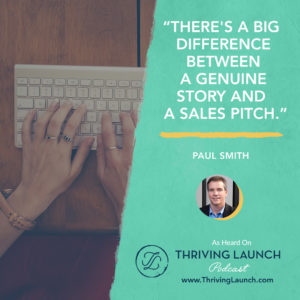

Paul Smith
So once you’ve decided what my message is, my message could be, “Well, I want you to buy this thing” or my objective could be, “I want you to buy this” or my objective could be, “I want you to come work for my company” or my objective could be, “I want you to work together more amiably with your peers” or, “I want you to be more creative” or, “I want you to work harder.”
There are all kinds of leadership in marketing and sales purpose. “I need to teach you how to do your job. I want to inspire and motivate my team.”
Finding The Elements Of A Story

Paul Smith
You got to decide your objective first and then, choose a story that will accomplish that objective.
The way to do that is that there are three things you ask yourself once you’ve decided what your objective is.
Ask yourself:
- When’s the last time I saw something like that done well?
- When’s the last time I saw something like that done poorly?
- When’s the time I learned that lesson myself the first time?
Those are the three places to go look to find a story because that way, you can either tell a success story. “Here’s how I’ve seen this done successfully in the past, and gosh, I’m hoping you do it as well.” Or, “Here’s the time I’ve seen this done awfully and badly somebody almost fired over. Gosh. I hope you don’t do that.” Or, “You know? I didn’t really realized how important this was until this thing happened to me. Let me tell you about that.” And then after that, you’re probably going to think it’s pretty important too.”
Start with your objective in mind, and then find a story that communicates that message either as a success, failure, or a moment of clarity.
Elements Of A Story That Make It Unique

Luis Congdon
Before we wrap up, one of the key points that’s standing out for me especially with the story about the pig is I’ve heard of this place with the swimming pigs, and it stuck out.
There’s an island somewhere in the world where there are swimming pigs, and that story made in imprint. I remember the picture that I saw.

Paul Smith
Right.

Luis Congdon
I clicked on that when I was just scrolling through my news on this app that sends me news from all the major publications, and all of that, and I saw this thing. It said something about swimming pigs in this island, and I was like, “What is that?”

Paul Smith
That’s pretty memorable.

Luis Congdon
Right, it’s very memorable.
It makes me think of how a lot of us tend to take the mundane and we keep it mundane. We can take something like a toothbrush or our services and if we can wrap it around some unique story, it changes the whole thing.
Here’s a good example. Kamala, we recently interviewed Keala. One of the things he talked about is he was in Las Vegas, walks into this place that caters the very rich people, and there’s a cellphone store. He walks in there, and no smartphones there. These are all like Nokia phones or flip phones.
The cellphones are those most us would have had when cellphones were just starting to boom, and these are $10,000 and up cellphones. They’re not some sort of breakthrough smartphone.
He talks to the guy because he was very interested in finding out like how are they able to even have a store and sell a phone for $10,000 and up. He asked the guy, “Hey, this is an interesting looking phone” and the guy says, “Yeah. It’s a really wonderful phone.”
Then, the guy from the store told Keala a little bit about the case, which was made out of pearl. He told him a little bit about that and the guy goes, “Oh, that’s interesting.” And he goes, “The reason why people like these phones is you lay it down, and everyone knows that that’s the boss’s phone. No one else has a phone just like yours. It’s your phone.” And he attached the elements of a story by telling him and creating significance by wrapping around a story.
The story is you have this phone that makes you more significant. But other than that, what is the value of a phone, and we can say that about a lot of things.
Making The Mundane Interesting Through The Elements Of A Story

Luis Congdon
So how do we make the mundane interesting? Do we need to look for some unique fact? Have you found any particular things to help people with that?

Kamala Chambers
Keala Kanae was his name just so you know. We struggle with that one.

Paul Smith
I’m sure that was much more impeccably pronounced than Luis did.
So, not every story you tell has to have elements of a story like that about the product that makes people want it.
What I found interesting especially in sales is that, great sales people tell stories throughout the entire sales process, and what we’re talking about right now is just during that main sales pitch itself.
If there is some kind of a background story behind it that you can polish up, practice, and get into a good shape using the questions, then that’s great. But if there’s not one, I don’t recommend going in inventing one or trying so hard to find one.
Leveraging The Elements Of A Story

Paul Smith
You can leverage storytelling throughout the entire sales process from introducing yourself to the buyer, to building rapport with them, to handling objections in the sale, to closing the sale, to even managing your customer relationships after you’ve made the sale.
In fact, there are 25 different types of stories I identified in the book that great salespeople and entrepreneurs that are in charge of business development for their firm need to be able to tell.
The pig island story and the pearl cell phone are few examples of those. That’s number 16. It’s how to add value to the product that you’re selling through a story.
But if you can’t find one for that, that’s fine. There are 24 other types of stories that you probably need to tell that you should devote some efforts to working on.

Kamala Chambers
That’s so fantastic.
Is there any last little gem you want to leave the Thriving Launchers with?
Drop The Word But Keep The Elements Of A Story

Paul Smith
Yeah. Drop the word “story” from your vocabulary.
Nobody wants to be told, “Hey. Let me tell you a story.” It sounds like that’s the way you want to kick off your stories but it turns out it does the opposite effect. It literally turns people off because they think you’re going to tell them a 15 or 20 minute long, boring, irrelevant story.
Don’t start your stories that way. Just start telling the story.

Kamala Chambers
This has been fantastic. We’ve been here with Paul Smith, talking about the elements of a story and how powerful it is.
I encourage you to go out and start applying these steps and the elements of a story Paul has given us today to create your own story.
You know it doesn’t have to be that long. You only need 300 words or 600 words story to make an impact, to be able to reach out, and connect with more people.
Thank you all for tuning in and keep thriving everyone.

